By Max Rohde
Amazon Cognito is a cloud-based, serverless solution for identity and access management. It provides capabilities similar to Auth0 and Okta.
Cognito is part of the AWS suite of services so you can easily incorporate it if you are already using AWS in other parts of your stack.
However, identity and access management are often tricky to implement, and Amazon Cognito is no different in that regard. This article provides a beginner's guide to get a basic setup with Cognito up and running. Specifically, it covers:
- 👀 An overview of an example application
- 📚 An explanation of key concepts we need to understand
- 🤗 How to sign up and authenticate users in a web application
- 🚪 How to secure endpoints in a server-side API
- 🛠 User management
This tutorial will strictly focus on authentication: that is, how to validate that a user is who they claim they are. It does not cover authorisation—although that is also something Cognito can help us with.
Here's a quick summary of authentication vs authorization if you'd like to read more.
Solution Overview
Before you embark on the journey of understanding how you will get authentication to work for your serverless application, I'll provide a brief overview of the solution you'll be able to develop using the concepts and code discussed in this article.
The application is deployed as a live demo. You are welcome to head over there and create an account.
All source code for this example is also available on GitHub for reference: cognito-react-nodejs-example.
Simple React UI
We'll have a simple user interface in React providing basic authentication functionality.
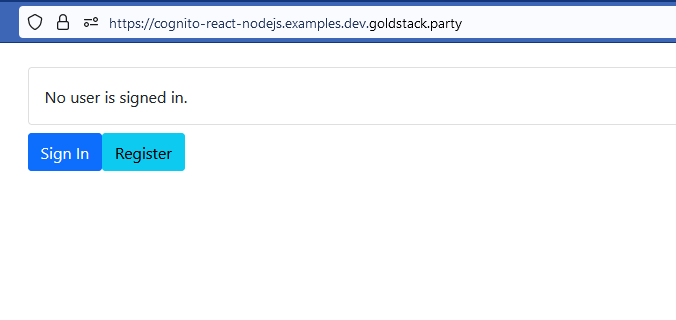
Registration
Upon clicking the Register button on the user interface (UI), the user will be redirected to a UI provided by Amazon Cognito that allows the user to register with an email address and password:
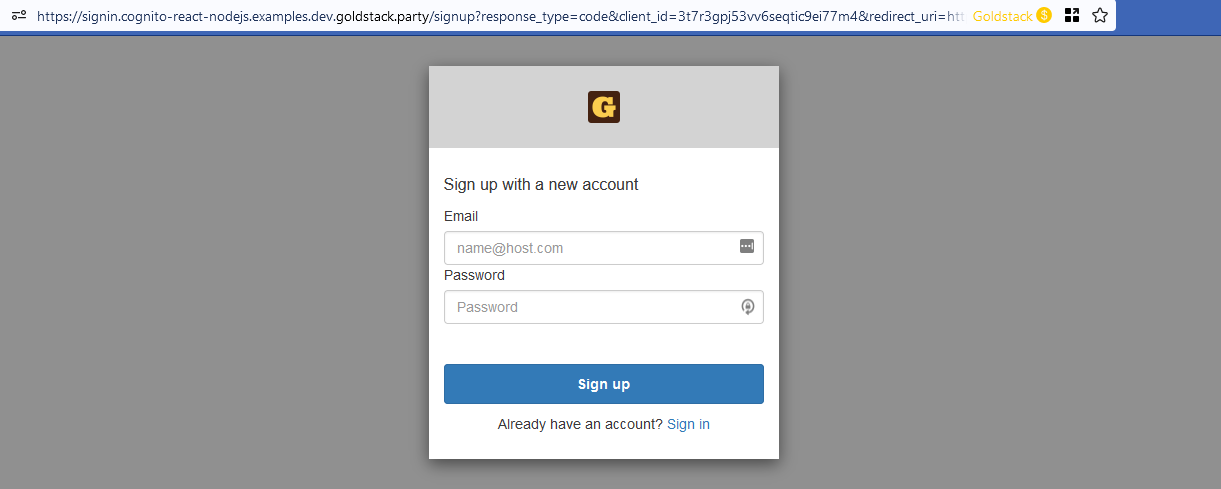
Upon providing an email address and password, the user will receive an email with a confirmation code that needs to be entered in the registration UI to complete the registration process.
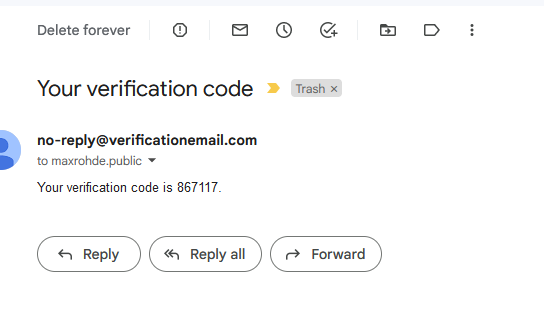
Signing in
Upon successful registration, the user is redirected to the original application and automatically signed in:
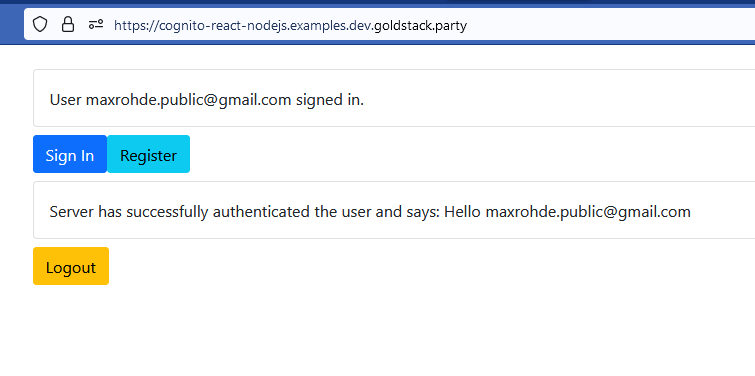
For users that already have an account, clicking the Sign In button will redirect them to a UI for signing in.
Server-side authentication
The example project utilises server-side rendering. The server authenticates the user, and upon successful authentication the server renders: Hello [email] into the HTML page sent to the client.

Logout
Finally, clicking the Logout button on the UI will log out the user and redirect to the sign in screen:
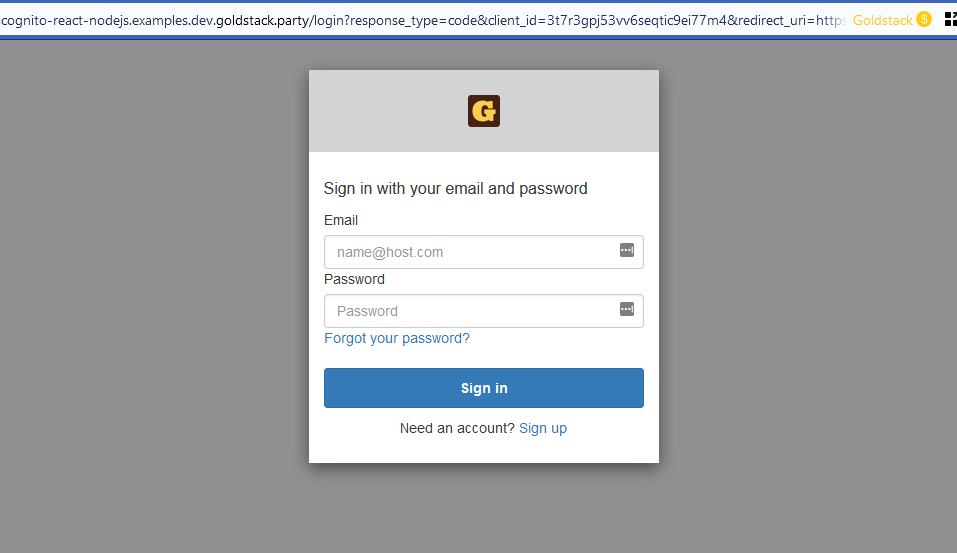
While the functionality in this example project appears relatively straightforward, there is both theoretical and technological complexity to deal with to make everything work.
However, once you have understood the concepts and technologies discussed in this article, you will be able to build an extremely low-cost, scalable, and secure solution for user management.
Key Concepts
To get some piece of code working, it is often enough to do a few quick Google searches and copy bits of code from here and there. This is not advisable for authentication.

You need basic grounding in a number of concepts to develop a solution. Principally, you need to learn a bit about OAuth 2.0 and Amazon Cognito, both of which I'll cover in the following sections.
What is OAuth 2.0?
OAuth 2.0 is an Internet Standard (see RFC 6749). Like other standards such as HTTP or SMTP, this standard is implemented by many applications, frameworks, services, and servers.
Popular services and servers implementing the OAuth 2.0 standard are:
OAuth 2.0 aims to provide both security and convenience for developers. One of its most attractive features is that it enables application owners to authenticate users without needing to store and manage users' passwords.

Naïve Authentication (Don't do this)
Let's first start with a naïve implementation of user authentication:

In this implementation, the user enters the username and password in the browser. We then send username and password to the server, which checks the credentials against those stored in a database.
If the credentials are correct, the server will issue a session id, which the client can include with future requests without further need to provide the username and password.
This implementation requires us to store passwords (or the hash of passwords in our database). This can easily result in serious security issues. Don't do this unless you absolutely have to.
OAuth Authentication Flow
OAuth 2.0 provides us with a better way to authenticate users. OAuth 2.0 is an extensive standard, and it offers multiple different authentication flows to authenticate users.
I will only describe one possible flow here – the one we will implement later in this article.
This flow consists of the following steps, each described in more detail below:
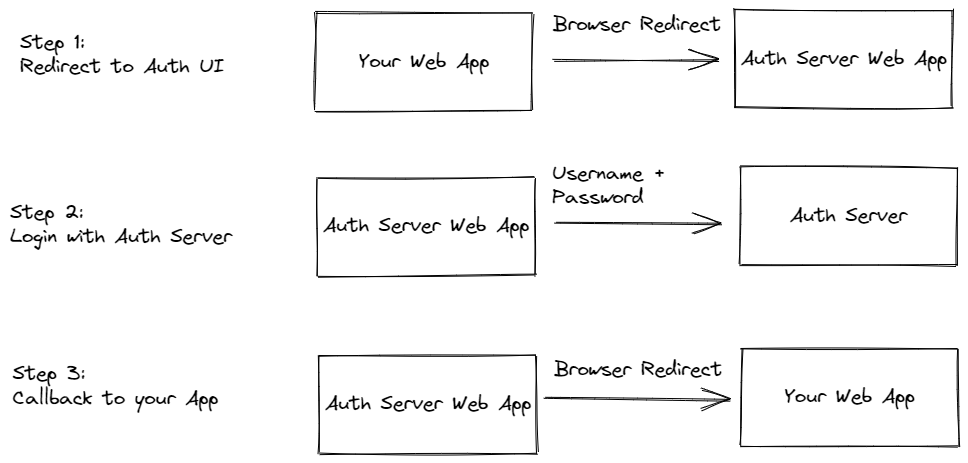
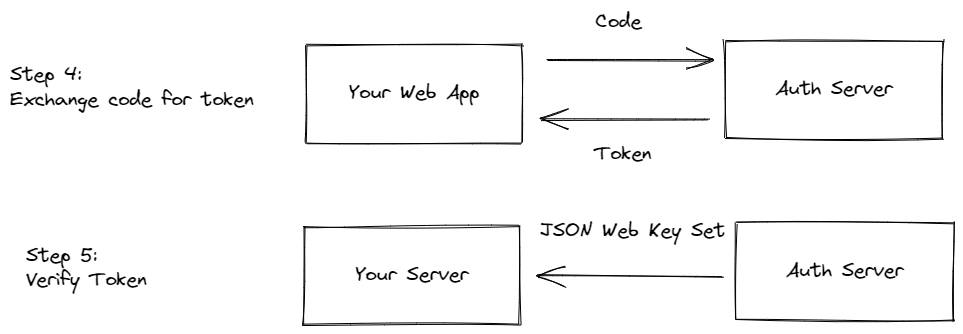
Step 1: Redirect to Authorisation UI
Rather than making an API call from our application with the username and password, we redirect the user from our web application to a web application hosted by our authorisation server.
So for instance, if your application is hosted at the URL https://myawesomeapp.com, you redirect the user to https://auth.myawesomeapp.com or https://auth.cloudprovided.com.
Step 2: Login with Authorisation Server
The user then provides their username and password on the page they are redirected to, and the authorisation server validates the provided credentials. You are not limited by simple username and password credentials here. Authorisation servers may implement two-factor authentication and/or other mechanisms.
The hosted web application of the authorisation server may also store cookies for already known users. Thus, if a client has been authenticated before, the authorisation server may not require the user to re-enter their credentials—but instead validate the information stored on the client
Step 3: Callback to your Application
Once the user is successfully authenticated, the authorisation server web application redirects the user back to your application. The URL used to call back your application contains an authorisation code. For instance, the URL the user is redirected to may look like:
https://myawesomeapp.com?code=xxxxxxxxxxx
Step 4: Exchange Code for Tokens
The application can then call the authorisation server API to exchange this code for a set of tokens.
You can either call the authorisation server API directly from your web application, or you could send the code to your server and have your server call the authorisation server API. The latter option would ensure the user's web browser would never have knowledge of the generated tokens. However, this requires implementation of some degree of session management for your server.
The tokens you get in exchange for the code are:
- ID Token: The id token contains information about a user's identity, such as name, email address or phone number.
- Access Token: The access token contains information about which resources the authenticated user should be given access to.
- Refresh Token: The refresh token can be used to request a new set of tokens from the authorisation server.
All these tokens are defined as JSON Web Tokens, also known as JWT.
The id token and access token work in quite a genius way. It is very easy for any application to parse them and extract the information they provide, for instance to obtain a user's email address from the id token.
Step 5: Verify Tokens
However, you shouldn't just read the information from these tokens and trust the information they provide. Instead, you should verify the tokens first.
You verify the tokens by downloading a public key provided by the authorisation server, provided in a JSON Web Key Set (JWKS). Usually, these are provided in a URL such as the following:
https://auth.yourapp.com/[...]/.well-known/jwks.json
After you have downloaded the public key, you can verify the tokens with this key. There are plenty of libraries available for this, see this list maintained by OpenID.
After you have verified the tokens, you can trust the information the tokens contain and use them in your application logic.
OAuth Authentication Flow: Some Security Hardening
OAuth 2.0 is an extensive standard, and it defines a number of optional features that help against common vulnerabilities.
One common vulnerability is the so-called redirect interception. We can protect against this by using PKCE (Proof Key for Code Exchange).
PKCE works by including a code challenge when initially redirecting the user to the authorisation server web application. For this, you generate a code verifier (a random sequence of characters). Then you generate a hash using SHA-256. You include the hash in the URL you redirect the user to:
https://auth.yourapp.com/loginui?...&code_challenge=[hash of code verifier]
You need to store the code verifier on the client, for instance in the browser's local storage.
When you exchange the authorisation code provided in the callback URL to your web application for tokens, you include the code verifier in the request.
The authorisation server will only issue the tokens, when the supplied code verifier matches the code challenge you have supplied with the initial request.
Cognito Concepts
Now that you know some OAuth basics, it is time to have a look at the specific technology used for the authentication server: Amazon Cognito.

I will not cover every aspect of Cognito here—I will only focus on what is required for the example application.
Specifically, I will cover:
- User Pools
- Application Clients
- Hosted UI
- Endpoints
I will also show you how to configure each of these using Terraform. In this section, I will reference Terraform source code from a template project on GitHub cognito-nodejs-template.
This template project is regularly updated with security patches and you can easily clone it to start your own Cognito project.
All TypeScript source code is referenced from the example project: cognito-react-nodejs-example.
User Pools
User pools in Cognito are essentially a database of users combined with some capabilities to sign up and sign in users.
User pools can be configured to allow users to sign up with their social logins (for example a Google Account or Facebook account) or via accounts created directly with Cognito.
The following snippet contains the configuration for the user pool used in the template project (main.tf):
resource "aws_cognito_user_pool" "pool" {
name = var.user_pool_name
# Add your app name to the below
email_verification_subject = "Your verification code"
email_verification_message = "Your verification code is {####}."
schema {
attribute_data_type = "String"
name = "email"
required = true
mutable = true
string_attribute_constraints {
min_length = 1
max_length = 100
}
}
username_attributes = ["email"]
auto_verified_attributes = ["email"]
password_policy {
minimum_length = 6
require_lowercase = false
require_numbers = false
require_symbols = false
require_uppercase = false
}
device_configuration {
challenge_required_on_new_device = true
device_only_remembered_on_user_prompt = false
}
}
Since the User Pool describes a database of users, you need to define what kind of data you want to store for users. This is defined in the schema property above.
The template project only configures one attribute for users: email. This allows you to store the user's email address.
I recommend defining the absolute minimum of attributes for users possible. This is because it is difficult to change the attributes later on. Therefore, we only define the email attribute here—since we plan to capture and validate it for our users.
The template also defines a password_policy for passwords users need to set. The User Pool in the example has a very permissive password policy—but you can change that easily by modifying main.tf.
Cognito provides some very powerful features such as allowing you to validate user email addresses automatically. This is achieved by setting the property auto_verified_attributes = ["email"].
Setting this will cause Cognito to send an email with a unique code to new users. Users will be validated and able to access the application only after they have entered this code with the Cognito UI.
Application Clients
You can use Cognito with both web and mobile applications. You need to provide specific configuration for every client you want to use.
The template provides configuration for a web client, which allows users to sign up through their web browser.
This is configured in web-client.tf in the template project:
resource "aws_cognito_user_pool_client" "client" {
name = "${var.user_pool_name}-client"
user_pool_id = aws_cognito_user_pool.pool.id
callback_urls = [var.callback_url]
default_redirect_uri = var.callback_url
allowed_oauth_flows_user_pool_client = true
allowed_oauth_flows = ["code", "implicit"]
allowed_oauth_scopes = ["email", "openid"]
supported_identity_providers = ["COGNITO",
# uncomment this to enable login with Google
# - remember to provide your application details in identity-providers.tf
# aws_cognito_identity_provider.google_provider.provider_name
]
}
resource "aws_cognito_user_pool_domain" "main" {
domain = data.aws_acm_certificate.wildcard.domain
certificate_arn = aws_acm_certificate.wildcard.arn
user_pool_id = aws_cognito_user_pool.pool.id
depends_on = [
aws_acm_certificate_validation.wildcard_validation,
]
}
resource "aws_cognito_user_pool_ui_customization" "ui" {
css = ".label-customizable {font-weight: 400;}"
image_file = filebase64("favicon-32x32.png")
# Refer to the aws_cognito_user_pool_domain resource's
# user_pool_id attribute to ensure it is in an 'Active' state
user_pool_id = aws_cognito_user_pool_domain.main.user_pool_id
}
To support the OAuth based authentication flow defined above, you need to enable OAuth in your client configuration.
The template is configured to allow sign up by providing an email or via Open ID. However, to enable Open ID, you need to provide additional configuration in identity-providers.tf, such as the identity of our application with the Open ID provider.
The above client configuration also provides some minor customisation of the user interface presented to users during sign up and sign in using the resource aws_cognito_user_pool_ui_customization.
Cognito by default hosts the UI for users on an Amazon owned domain but you can customise it to allow users to sign up and sign in on a domain you own. The template customises the domain name to data.aws_acm_certificate.wildcard.domain. This is accomplished using the resource aws_cognito_user_pool_domain.
Lastly, you need to define a callbackUrl. This is the URL in your web application that users are redirected to after a successful sign in. Cognito supports multiple callback URLs but we only provide one in the template project.
Endpoints
After you have configured your User Pool and Application Client, Cognito will host a number of endpoints for you.
These are all hosted under the custom domain you configured for the Application Client.
The following endpoints will be provided:
Sign In
https://{domain}/oauth2/authorize
This provides a UI that defaults to allowing users to sign in, but also allows users to sign up or reset their password, or recover a lost password. Redirect users to this page to initiate the OAuth sign up flow.
Sign Up
https://{domain}/signup
This provides a UI that defaults to prompting users to sign up for the application.
Get Token
https://{domain}/oauth2/token
An endpoint you can make a POST call to obtain the Access, Identity and Refresh tokens, given a valid code is supplied during the authentication flow.
Logout
https://{domain}/logout
Redirecting users to this URL from your web application will force them to log out.
Note that all these endpoints need to be parametrised using information from your application, Application Client, and User Pool. The provided template uses a library to construct the correct URLs. Source code for the library can be found in cognitoEndpoints.ts:
switch (args.endpoint) {
case 'authorize':
return (
`${baseUrl}/oauth2/authorize?response_type=code` +
`&client_id=${deploymentOutput.terraform.user_pool_client_id.value}` +
`&redirect_uri=${deployment.configuration.callbackUrl}` +
'&code_challenge_method=S256' +
`&code_challenge=${await getCodeChallenge()}`
);
case 'signup':
return (
`${baseUrl}/signup?response_type=code` +
`&client_id=${deploymentOutput.terraform.user_pool_client_id.value}` +
`&redirect_uri=${deployment.configuration.callbackUrl}` +
'&code_challenge_method=S256' +
`&code_challenge=${await getCodeChallenge()}`
);
case 'token':
return `${baseUrl}/oauth2/token`;
case 'logout':
return (
`${baseUrl}/logout?response_type=code` +
`&client_id=${deploymentOutput.terraform.user_pool_client_id.value}` +
`&redirect_uri=${deployment.configuration.callbackUrl}` +
'&code_challenge_method=S256' +
`&code_challenge=${await getCodeChallenge()}`
);
}
How to Sign Up and Authenticate Users
Once Cognito is configured correctly as outlined above, you can start signing up users for your application.
There are multiple ways to do this, but generally you begin by redirecting users from your web application to the URLs described in the previous section.
In this section, I will reference the example project: cognito-react-nodejs-example as opposed to the template project (cognito-nodejs-template) referenced in the previous sections.
The example project won't be automatically updated like the template project. But it provides an integrated example that contains both the Cognito configuration as well as a simple web application, which will make it easier to follow along with the concepts discussed in this section.
I have also wrapped a number of convenience functions in a library that is published to npm: @goldstack/template-user-management. The source code for that library is available here.
The example project utilises yarn workspaces and contains two packages:
packages/server-side-renderingto define the custom web application users interact with.packages/user-managementto define the Cognito configuration and a basic wrapper around the Cognito API.
I love workspaces since they allow you to develop fullstack applications in a clean, modular manner. For more information on the how and why of the basic project setup, please see my article The Ultimate Guide to TypeScript Monorepos .
Our simple application contains just one screen that is defined in the server-side-rendering package: $index.tsx.
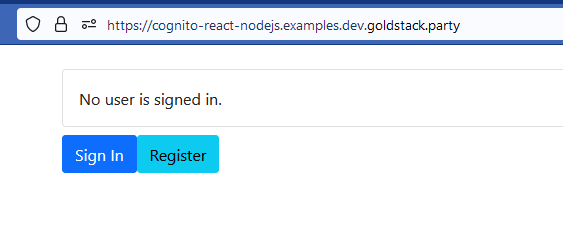
I abbreviate below the key logic for authentication provided in the index handler:
import {
getLoggedInUser,
handleRedirectCallback,
loginWithRedirect,
} from 'user-management';
const Index = (props: { message: string }): JSX.Element => {
const user = getLoggedInUser();
handleRedirectCallback();
return (
<>
{!user && (
<button
onClick={() => {
loginWithRedirect();
}}
>
Sign In
</button>
)}
</>
);
};
Importing the user-management package allows you to access a number of convenience methods required for interacting with Cognito in the web application. See the module users.ts in the user-management package for reference.
The method getLoggedInUser() will return the identity and access token for the user if a user is logged in.
The method handleRedirectCallback() performs the logic the client needs to go through for the steps of the authorisation flow that callback to the client. Specifically, the method:
- Checks if there is a
?codeparameter in the URL. - If there is, calls the
tokenendpoint with the providedcodeto obtain the user tokens (identity, access and refresh). - Uses a refresh token (if available) to obtain new identity and access tokens.
The method loginWithRedirect() will redirect the user to the Cognito provided UI if the user is not authenticated yet.
The page defined in $index.tsx uses a few further methods:
signUpWithRedirect()which works just likeloginWithRedirect()but defaults the Cognito UI to the sign up as opposed to the sign in flow and is hooked up to the Register button in the example application.performLogout()which will log out the user.
Securing Endpoints
Once you have obtained the tokens on the client-side, you can send them back to the server—by default the template will write them into a client-side cookie, but you can also send them along as Bearer Tokens in headers for custom requests.
In the server-side logic, you can again import the user-management module. Using the method connectWithCognito, you can validate the access token and identity token passed from the clients:
import { connectWithCognito } from 'user-management';
export const handler: SSRHandler = async (event, context) => {
const cookies = getCookies((event.cookies || []).join(';'));
if (cookies.goldstack_access_token) {
const cognito = await connectWithCognito();
await cognito.validate(cookies.goldstack_access_token);
const idToken = await cognito.validateIdToken(cookies.goldstack_id_token);
message = `Hello ${idToken.email}<br>`;
}
};
See the index route server-side handler in the example project for a complete source code reference.
Note that it is extremely important to call the validate() methods on the tokens, and not just directly decode them to read their contents. The API developed in this example will only be secured if you validate the tokens.
User Management
Once you have signed up users for your application, you may need to do some administrative work with them – such as resetting passwords or exporting the list of all users.
You can do this easily using the AWS Console. Search for the service Cognito and then select Manage User Pools.
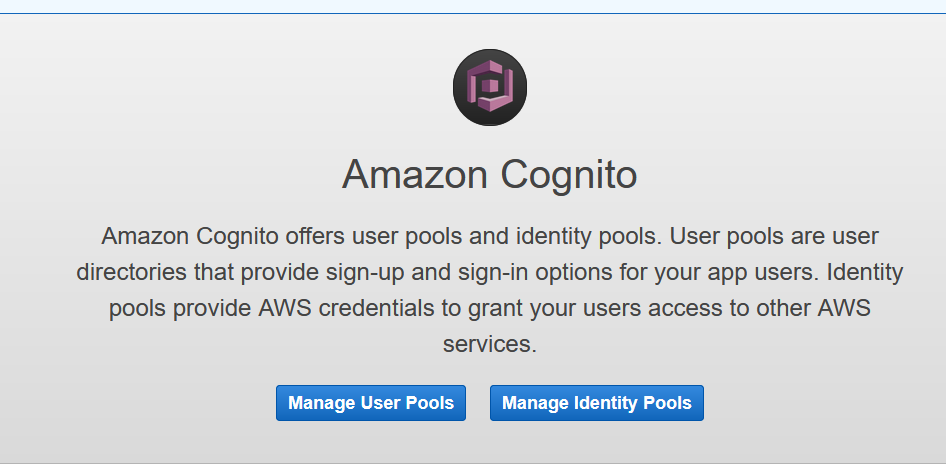
Then select the user pool that was created and go to General Settings / Users and Groups. Here we can see a list of all signed up users:
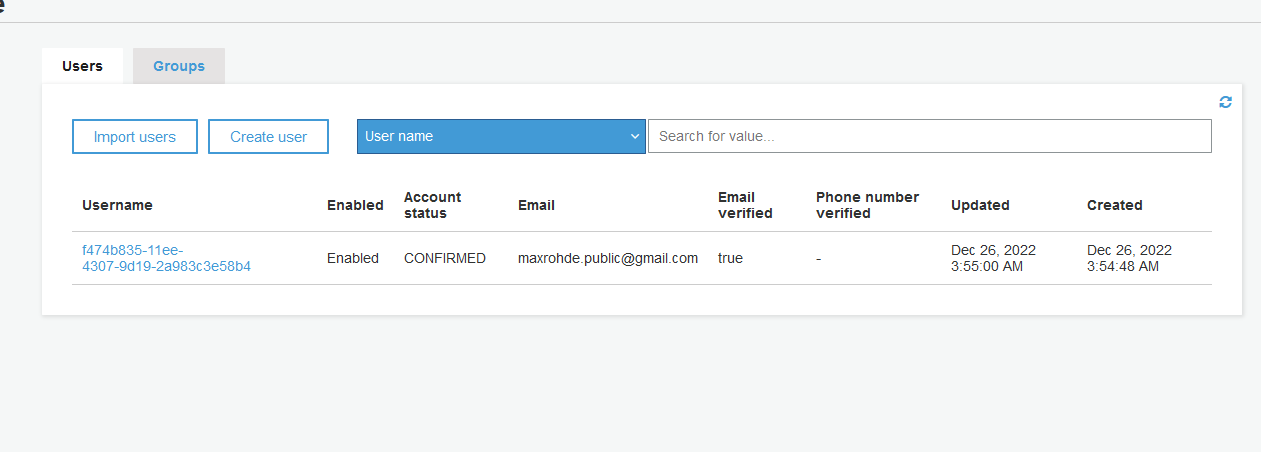
Please do not change any other settings in the AWS console. All changes to the user pool configuration should be done by modifying the provided Terraform configuration files.
Conclusion
Many applications require registering and identifying users. Unfortunately, providing user authentication features can become quite complicated.
In this article, I have shown how to create a simple application that allows signing up and signing in users securely.
Amazon Cognito solves most of the hard problems for us. For instance, there is significant complexity involved in handling email verification or a functionality to recover last passwords.
By using the default solutions provided by Cognito, chiefly the hosted UI, you can keep your application light and focus on the unique problems you want to solve.
However, as with any out-of-the-box solution, you sacrifice flexibility and extensibility. The example project and template provide all configuration in Terraform and can be modified to your needs—but that won't always be easy.
All in all, I highly recommend using an existing platform for managing customer identity. Auth0 and Okta are probably preferable to Cognito if you are not bound to AWS. For this article, I chose Cognito since I have been working on building a complete serverless stack for AWS.
In my articles, I go beyond providing code snippets and provide libraries and templates that give you a head start in getting your application up and running. You can help make the journey even easier for others, by reaching out to me with ideas to improve the article or, even better, by helping to improve the template and example project.
